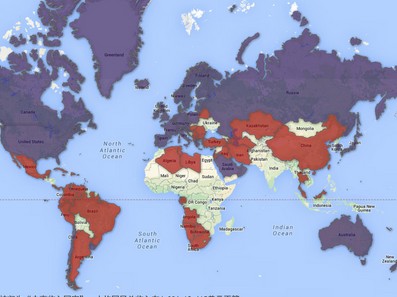When an official from China's National Development and Reform Commission noted (in Chinese) that the country has graduated to 'upper-middle income' status, the reaction online was cynical.
当中国国家发展和改革委员会的一名官员称中国已进入“中高收入国家”行列时,网络上出现了激烈的反应。
Xu Lin, head of the NDRC's planning office, may have meant to draw attention to China's achievements in economic development, but he only stirred up a wasp's nest of sardonic commentary noting China's stark inequalities, as well as the rising house prices and shortage of white-collar jobs that make the middle classes so mad.
发改委规划司司长徐林的本意或是想吸引人们关注中国经济发展的成就,但他这一言论却捅了中国网民情绪的马蜂窝,网民们纷纷对中国巨大的贫富差距、高房价和白领岗位不足等中产阶级不满的问题大加嘲讽。

Yet Mr. Xu was right, at least according to the World Bank. The organization's definition of upper-middle income is sufficiently generous to include China, with a lower threshold of just $4086 a year in gross national income (a slightly different yardstick from the more often used gross domestic product). On this measure, China is slightly richer than Namibia but slightly poorer than Peru.
图表:世界收入地图 不过至少以世界银行(World Bank)的数据来看,徐林的话是对的。世界银行对中高收入国家的定义足以将中国囊括其中,其下限仅为年人均国民收入(GNI)(该指标与国民生产总值(GDP)略有差异)4086美元。以这一指标衡量,中国略富于纳米比亚,但略穷于秘鲁。
The World Bank's list of upper-middle income countries has 55 members and covers much of Latin America, the less-wealthy parts of the middle east, the poorest countries in Europe and the richest countries in Africa. As our map shows, China's economic peers range from Colombia to Kazakhstan.
世界银行的中高收入国家名单内有55个国家和地区,包括拉丁美洲的大部分国家、中东地区不太富裕的国家,欧洲最贫穷的国家和非洲最富裕的国家。正如地图所示,与中国收入水平相当的还包括哈萨克斯坦和哥伦比亚等国家。
On one level, it is an achievement for China to make it into a club that also includes Brazil, Mexico and South Africa - though it still brings up the rear of that group. As of 2012, China's per capita GNI was about half of Brazil's. Still, a generation ago, China lagged much further behind.
从某种层面上讲,中国已跻身一个包括巴西、墨西哥、南非等国的俱乐部,这对中国来说算是一大成就,尽管中国在该俱乐部中的排名仍然靠后。截至2012年,中国的人均国民总收入(GNI)只有巴西的一半。当然,几十年前,中国人均GNI排名还要落后得多。
But all of these countries face long odds when it comes to matching western living standards in the forseeable future. Many of them have gone through spurts of high growth accompanied by wild optimism, only to slip into the economic doldrums again.
但说到是否能在可预见的未来赶上西方生活水平,这些国家的胜算都不大。其中的许多国家都曾经历井喷式的高速经济增长,并伴随着盲目的乐观,但随之而来的是经济再度陷入低迷。
Argentina began the twentieth century as one of the richer countries in the world; today, after becoming the most prolific national defaulter, it is wrestling with a tumbling currency and soaring inflation.
在二十世纪初,阿根廷曾是世界上比较富裕的国家之一。但在成为全球最大倒账国之后,如今阿根廷正艰难应对本币贬值和通胀飙升。
Likewise, in the late 1960s and early 1970s, Brazil logged some of the highest growth rates in the world - only to see the 'Brazlian economic miracle' floored by runaway inflation and a debt crisis that turned the 1980s into a 'lost decade.'
同样,在1960年代末到1970年代初,巴西经济增速曾创下世界之最,然而“巴西经济奇迹”随后迎来恶性通胀和一场债务危机,使巴西在1980年代经历了“失去的十年”。
Only a handful of economies have escaped from this so-called 'middle income trap.' Despite a few wobbles, South Korea and Taiwan have virtually achieved western living standards, leaving economists - not least in China - debating what these Asian tigers did right that so many Latin American countries did wrong.
只有少数经济体避开了所谓的“中等收入陷阱”。虽然有点跌跌撞撞,但韩国和台湾实际上已经达到西方的生活水平,这促使经济学家们(尤其是中国的经济学家们)就亚洲四小龙当时做对了什么、许多拉美国家做错了什么展开激辩。












